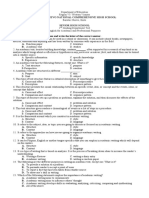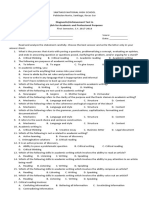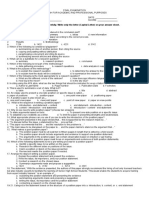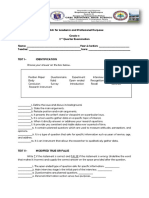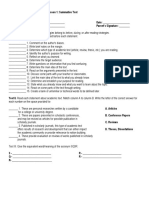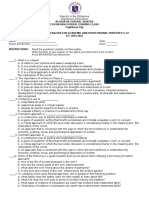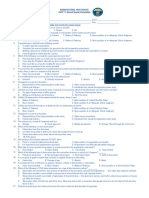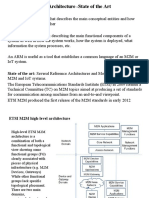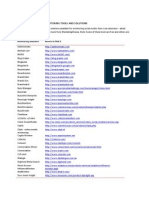EAPP Midterm (rEVIEWER
EAPP Midterm (rEVIEWER
Uploaded by
CHERRY ANN OLAJAYCopyright:
Available Formats
EAPP Midterm (rEVIEWER
EAPP Midterm (rEVIEWER
Uploaded by
CHERRY ANN OLAJAYOriginal Title
Copyright
Available Formats
Share this document
Did you find this document useful?
Is this content inappropriate?
Copyright:
Available Formats
EAPP Midterm (rEVIEWER
EAPP Midterm (rEVIEWER
Uploaded by
CHERRY ANN OLAJAYCopyright:
Available Formats
Department Of Education
Region IX, Zamboanga Peninsula
Division of City Schools
AYALA NATIONAL HIGH SCHOOL
Senior High School Department
REVIEWER
English for Academic and Professional Purposes
Directions: Read each questions carefully and write the letter/group of words that corresponds to the question.
1. It is usually in the form of a list divided into headings and subheadings that distinguish main points from
supporting points.
a. Format b. Outline c. Outlining d. Academic texts
2. This a kind of outline defined as a skeletal overview of your draft, which contains your fundamental points and
the different ideas support them.
a. Outline b. Outlining c. Written Outline d. Reading outline
3. The traditional outline numbering consists of the following except one.
a. A.I.1.a. b. I.A.1.a c. 1.I.A.a d. I.A.a.1.
4. This is a short statement that expresses the main point or claim of a text.
a. Introduction b. academic texts c. thesis statement d. research articles
5. It is an act of rephrasing the lines according on how one understands a text.
a. Precis b. Paraphrase c. Summarizing d. Thesis Statement
6. This is summing up of presented material in a relatively less lengthy than the original. It restates only the author’s
main ideas, omitting extraneous examples and evidence used in supporting and illustrating points.
a. Precis b. Abstract c. Summary d. Paraphrase
7. In writing your thesis statement, the following are suggested except for one.
a. You must be clear and concise. c. Jargons are used.
b. Simplicity is the key d. Never be vague.
8. This is a formal requirement for publication, usually seen at the first part of a research or a thesis.
a. Precis b. Abstract c. Summary d. Paraphrase
9. This outline’s purpose is to get the main ideas of a text that is already written.
a. Outlining b. Written Outline c. Reading Outline d. Thesis statement
10. It is summing up an academic or an official document but using one’s own words. It is paraphrasing in a
academic way.
a. Precis b. Abstract c. Summary d. Paraphrase
11.What idea does not justify a reaction paper?
a. A reaction paper is written for enlightenment of one’s fellow human being.
b. A reaction paper helps reader in his everyday decision.
c. A reaction paper writes to prove a point.
d. A reaction paper is a way to rage against petty insults and grievances.
12.Rodrigo is tasked to make a research paper. If you’re him, what is the first thing to consider?
a. Make a conclusion b. choose a topic c. gather the data d. analyze the data
13.What do the writers say about their research findings?
a. They had predicted the results correctly.
b. They felt people responded dishonestly.
c. They had conflict with those of other researchers.
d. Happiness levels are higher than they had believed.
14. How do you write a good academic text?
I. Good academic text means using unfamiliar word
II. Good academic text follows set of rules, standards and practices in writing.
III. The language, style and tone must be appropriate to convey your purpose to the target audience.
a. I b. I and III c. II and III d. III
15.As a reader how would you evaluate a good reaction paper?
a. If the writer uses common words
b. If the writer follows subject-verb agreement
c. If the writer follows the standards in writing a reaction paper
d. If the writer punctuates well the sentences.
16.In writing a concept paper, the following techniques could be used, except for one.
a. Clarification b. Definition c. Explication d. Summary
17.In writing a concept paper, how the author should use the definition technique?
a. The author should perform close reading.
b. The author should discuss coherently the meaning of a word, phrase or an idea.
c. The author should explain by giving supporting details or examples.
d. The author should elaborate further and give meaningful examples.
18. The following are the possible parts of introduction except one..
a. Explanation on how your work coincides with the mission
b. Brief description about your proposed project
c. Information about the funding agency
d. Support system of your research
19.Characteristic of a writer manifested in keeping away from his own prejudice, opinion or emotions regarding the
topic he/she wants to tackle?
a. persuasive b. subjective c. objective d. credible
20.The mission of your research that you want to achieve.
a. Conclusion b. Introduction c. Objective d. Timeline
21.When you are defining the term based from the dictionary, what kind of definition in academic writing it is?
a. Conceptual b. Boundary-based c. Central-focused d. extensional
22.What should not be considered in using clarification writing technique?
a. define b. explain c. interpret d. expound
23Why concept paper requires writing techniques?
a. To persuade b. to convince c. to elucidate d. all of the above
24.In Bernales, et al. (2016), the following characteristics of a good critique are as follows, except..
a. objective b. untimely c. decisive d. comprehensive
25.In writing a review or critique, what is the first thing you need to do?
a. Decide what make things good c. decide what to look at
b. Decide what make things bad d. write your review
26.It is a critical approach that you may employ in writing a review where in the reader’s role cannot be separated.
a. Marxist criticism b. Reader-response criticism c. Formalism d. Feminism
27.The common aspects looked into when using Marxist criticism are as follows, except..
a. convergences between economic classes c. social class of the writer creator
b. b. social class of the characters d. social class as represented in the work
28.Knowledgeable of the topic and the genre of the text is a characteristic that a ______ must possess.
a. Critique b. Critic c. Review d. Criticism
29.When you rephrase the lines on how you understand them, it shows ____.
a. Paraphrase b. précis c. abstract d. summary
30. These are educational texts that are used in school or classroom.
a. Academic texts b. Academe texts c. Anything that is used in the Academe d. School
books, newspapers,etc.
31. This is a type of academic text that are specifically designed to help the learner. It is handy, and it
includes summaries and quizzes.
a. Essay b. thesis c. textbooks d. dissertations
32. These are academic texts that are longer and is done in the college and post-college levels.
a. Essay b. theses c. textbooks d. laboratory reports
33. The structure and style of academic texts vary across disciplines, but mostly they include the following except
this.
a. Conclusion b. introduction c. recommendations d. research articles
34. This is an academic text which is common in disciplines such as business, sociology, and law.
a. Research articles b. case studies c. overview d. reports
35. Reading in discipline means one must have a good foundation of the general science since this discipline
becomes complex as time goes by.
a. Mathematics b. Literature c. Science d. History
36. In discipline, you must use rhetorical tools in understanding a range of warrantable interpretations of
complex literary works.
a. Mathematics b. Literature c. Science d. History
37. This refers to how information is organized in a passage.
a. Three-part essay b. text structure c. Introduction d. IMRaD
38. IMRaD is short for these sections.
a. Introspection, Methodology, Research and Discussion c. Introduction, Measurement, Results and
Discussion
b. Introduction, Methodology, Research, and Discussion d. Introduction, Methodology, Results and
Discussion
39. This is an important part of the text structure. This is where the whole text is summarized.
a. Introduction b. Conclusion c. Discussion d. Results
40.In summarizing a text that you have read, what tip will be of great help?
a. Read the text once only b. use simple future tenses c. skim the text d. none of the above
41A kind of concept paper that is written before the research work.
a. Prospective b. Retrospective c. Reflective d. Retroactive
42.Being _______, this concept paper makes use of verbs in the past tense.
a. Prospective b. Retrospective c. Reflective d. none of the above
43.In academic writing, specifically in research, a ____________serves as an introduction to the text that will be
presented.
a. Concept paper b. Position Paper c. Reaction Paper d. Critique Paper
44.When writing your own concept paper, keep in mind the following tips, except..
a. Structure is the key b. Build your words c. Be subjective d. Be Persuasive
45.What common aspect looked into when using feminism approach?
a. Shows culture determines gender c. unity in the works
b. Social class of the characters d. author’s technique
46.Use of imagery to develop the symbols in the work is an aspect looked into _______.
a. Marxist criticism b. Reader’s-response criticism c. Feminist criticism d. Formalism
47.Why reading academic texts is a must for all the students in almost all subjects and courses?
a. To make students better academic readers c. To improve critical thinking skills
b. A requirement in the curriculum d. all of the above
48.When you are judging the strength or validity of the author’s arguments, you are _____.
a. Summarizing the text b. evaluating the text c. outlining the text d. annotating what you read
49.Every academic text has a thesis statement, in writing it what tip maybe useful?
a. say much b. use jargons c. be clear and concise d. take sides
50.What kind of writing defines an idea and explains the essence in order to clarify the “whatness” of that idea?
a. Research paper b. Concept paper c. Position paper d. Reaction paper
51.In the introduction paragraph of a review or critique, you must catch the reader’s _______.
a. attention b. ability c. skill d. talent
52.In research, terms, variables, and ideas maybe defined ______ or _________.
a. intensional or extensional c. genus or differentia
b. definiendum or definiens d. conceptual or operational
53.If you want to simplify concepts or to clear any confusing ideas, what writing technique you may use?
a. Clarification b. Definition c. Explication d. Exposition
54.How do you write a good concept paper?
a. by constructing fragmented sentences c. by following the standard format and structure of writing a
concept paper
b. by having irrelevant details d. by making an appropriate and satisfying conclusion
55.________ definition identifies which belong or does not belong to the group, class, object, word or concept being
defined.
a. Operational b. Boundary-based c. Extensional d. Central-focused
56. The writer’s way of expressing himself can _______ or _____the reader.
a. convince b. bore c. a and b d. none of the above
57.It is interpreting specific points of a text and analyzing it thoroughly.
a. definition b. explication c. clarification d. summary
58.Why an outline for a concept paper is a necessity?
a. To make sure that the concept paper is coherent
b. Adhere to standard set by the institution
c. To make sure that the concept paper is reliable
d. None of the above
59.In choosing the outline for your concept paper, it should be ______ by your teacher/institution, or one that best
suits your purpose.
a. approved only
b. recommended only
c. approved and recommended
d. none of the above
60.Hanan is a creative consultant of their company. She wants to propose and introduce a research project. What
academic paper should be prepared?
a. Conceptual paper b. concept paper c. Explication paper d. Research paper
You might also like
- Google Analytics Exam AnswersDocument113 pagesGoogle Analytics Exam AnswersCertificationAnswers80% (5)
- Modified True or False. Write EAPP If The Statement Is True. If The Statement Is False, Underline TheDocument2 pagesModified True or False. Write EAPP If The Statement Is True. If The Statement Is False, Underline TheErika PhoebeNo ratings yet
- Macro MicroDocument7 pagesMacro MicroHardi Yanti Purnama100% (1)
- Eapp-Posttest 1ST Sem 2021-2022 2Document2 pagesEapp-Posttest 1ST Sem 2021-2022 2lomapo100% (1)
- 1st Quarter Exam EAPPDocument5 pages1st Quarter Exam EAPPedzil almogueraNo ratings yet
- Department of Education: English For Academic and Professional PurposesDocument3 pagesDepartment of Education: English For Academic and Professional PurposesJennifer MayanoNo ratings yet
- Barotac Nuevo National Comprehensive High SchoolDocument4 pagesBarotac Nuevo National Comprehensive High SchoolsheilaNo ratings yet
- EAPP 1st Q-ExamDocument6 pagesEAPP 1st Q-ExamRomeo Espinosa Carmona JrNo ratings yet
- Eapp Summative TestDocument4 pagesEapp Summative Testjuainy aggabaoNo ratings yet
- EAPP 1st QuarterDocument5 pagesEAPP 1st QuarterJohn Paul FornillosNo ratings yet
- EAPP ExamDocument4 pagesEAPP ExamEri Echalar100% (1)
- 2nd Quarter Examination EappDocument6 pages2nd Quarter Examination EappDana Althea AlgabreNo ratings yet
- Pretest Eap 2ndquarterDocument2 pagesPretest Eap 2ndquarterJohaimah Macatanong100% (1)
- EAPP Diagnostic TestDocument6 pagesEAPP Diagnostic TestChristian EaNo ratings yet
- Diagnostic Test N EappDocument5 pagesDiagnostic Test N Eappcherish mae oconNo ratings yet
- Eapp 1st QuarterDocument6 pagesEapp 1st QuarterNors Cruz100% (2)
- EAPP 4th Periodical ExamDocument3 pagesEAPP 4th Periodical ExamKay Kay Mauryn ManangapNo ratings yet
- Exam EAPPDocument4 pagesExam EAPPStephanie AturdidoNo ratings yet
- Eapp Final ExamDocument3 pagesEapp Final ExamDA FTNo ratings yet
- 1st Summative Test in EAPPDocument2 pages1st Summative Test in EAPPEdmar BarridoNo ratings yet
- Schools Division of Negros Oriental: Dauin National High SchoolDocument2 pagesSchools Division of Negros Oriental: Dauin National High SchoolCow Cow CowNo ratings yet
- EAPPDocument2 pagesEAPPzurlexNo ratings yet
- EAPP Test QuestionsDocument6 pagesEAPP Test Questionsronaliza c. cerdenolaNo ratings yet
- English For Academic and Professional Purposes 1ST Quarter ExamDocument3 pagesEnglish For Academic and Professional Purposes 1ST Quarter ExamEvangeline MendezNo ratings yet
- Eapp Summative Final ExamDocument4 pagesEapp Summative Final ExamcocopitlabmixNo ratings yet
- Third Quarter Diagnostic Test: Second Semester, S.Y. 2019-2020Document11 pagesThird Quarter Diagnostic Test: Second Semester, S.Y. 2019-2020Samantha RullaNo ratings yet
- Directions: Simple Recall: Encircle The Letter of The Best AnswerDocument7 pagesDirections: Simple Recall: Encircle The Letter of The Best AnswerTrixiaNo ratings yet
- 1st Periodical EAPP EditedDocument4 pages1st Periodical EAPP EditedMichelle Mirador MinimoNo ratings yet
- Lesson 3: Academic Reading StrategiesDocument26 pagesLesson 3: Academic Reading Strategiesنجشو گحوشNo ratings yet
- INSTRUCTIONS: Read Each Question Carefully. Write Only The Letter (Capital Letter) On Your Answer SheetDocument2 pagesINSTRUCTIONS: Read Each Question Carefully. Write Only The Letter (Capital Letter) On Your Answer SheetChar LayiNo ratings yet
- 2nd Quarter Exam EappDocument4 pages2nd Quarter Exam EappCecille HernandoNo ratings yet
- Eap Midterm Exams 2nd Sem 2021Document3 pagesEap Midterm Exams 2nd Sem 2021Li Lian AnaniasNo ratings yet
- APP 3 - PR 1 (4th Quarter Exam)Document4 pagesAPP 3 - PR 1 (4th Quarter Exam)Benjie GoodNo ratings yet
- EAPP 2nd QuarterDocument2 pagesEAPP 2nd QuarterBernard BaruizNo ratings yet
- FINAL EXAM in 21st Century Literature From The Philippines and The WorldDocument4 pagesFINAL EXAM in 21st Century Literature From The Philippines and The WorldMar Jun ParaderoNo ratings yet
- Summative Test in Oral ComDocument5 pagesSummative Test in Oral ComAltis MolpenNo ratings yet
- 1st Quarter Examination in EAPP 12Document6 pages1st Quarter Examination in EAPP 12Jerome Gliponeo100% (1)
- English For Academic and Professional Purposes - MELC AlignedDocument65 pagesEnglish For Academic and Professional Purposes - MELC AlignedMarlon Gonzales100% (1)
- EAPP Lesson 1 - Summative TestDocument1 pageEAPP Lesson 1 - Summative Testjhen tiongsonNo ratings yet
- Exam EAPPDocument2 pagesExam EAPPKer Saturday100% (5)
- Directions: Read The Statements/selections Carefully. Write The Letter of Your Choice On Your Answer SheetDocument2 pagesDirections: Read The Statements/selections Carefully. Write The Letter of Your Choice On Your Answer SheetAUSTIN ESCOLNo ratings yet
- 2020 3rd Q EXAM - RW FinalDocument2 pages2020 3rd Q EXAM - RW FinalJulieAnnLucasBagamaspadNo ratings yet
- 2nd PERIODICAL TEST IN EAPPDocument6 pages2nd PERIODICAL TEST IN EAPPcherish mae oconNo ratings yet
- English For Academic and Professional Purposes: Which Is The Better Paraphrase?Document5 pagesEnglish For Academic and Professional Purposes: Which Is The Better Paraphrase?Carrie Alyss P Eder-IbacarraNo ratings yet
- Concept Paper G3ReportDocument61 pagesConcept Paper G3ReportBITCOIN EARNERNo ratings yet
- English For Academic and Professional Purposes Pretest: ST NDDocument7 pagesEnglish For Academic and Professional Purposes Pretest: ST NDsaramina CandidatoNo ratings yet
- Eapp Prelim Exam Key To CorrectionsDocument9 pagesEapp Prelim Exam Key To CorrectionsMia QuimsonNo ratings yet
- Thesis Statements PowerPointDocument51 pagesThesis Statements PowerPointdadais1100% (1)
- Reading and Writing Summative 1 4Document11 pagesReading and Writing Summative 1 4Christine CastroNo ratings yet
- First Quarter Exam in EAPPDocument4 pagesFirst Quarter Exam in EAPPBrando Sayson100% (1)
- 2nd Diagnostic Test in EAPPDocument3 pages2nd Diagnostic Test in EAPPGilbert NarteNo ratings yet
- Exam in EAPP 2019Document2 pagesExam in EAPP 2019Sumugat TricyNo ratings yet
- Q2 Exam EappDocument3 pagesQ2 Exam EappRachelKisses GuzmanNo ratings yet
- Grade 12-Eapp-Lesson 4 - Quarter 1Document11 pagesGrade 12-Eapp-Lesson 4 - Quarter 1Maria Cecilia LoristoNo ratings yet
- 2ND Periodical Exam Eapp 11 (Final)Document3 pages2ND Periodical Exam Eapp 11 (Final)Laiden Mae D. BacusNo ratings yet
- EAPP Summative Test Q1 Week 7 8Document2 pagesEAPP Summative Test Q1 Week 7 8Hiyyih HueningNo ratings yet
- Eapp Prelim ExamDocument6 pagesEapp Prelim ExamErika MendozaNo ratings yet
- Paraphrasing Self AssessmentDocument2 pagesParaphrasing Self AssessmentMAGU_MWENYEWENo ratings yet
- Reading and WritingDocument3 pagesReading and WritingRichard Alicaway50% (2)
- EAPP - Second Quarter ExamDocument5 pagesEAPP - Second Quarter ExamRomnickCelestinoNo ratings yet
- Victorias National High School: I. Directions: Read The Questions Carefully and Choose The Letter of The Correct AnswerDocument2 pagesVictorias National High School: I. Directions: Read The Questions Carefully and Choose The Letter of The Correct AnswerGladys CastroNo ratings yet
- Media and Information Literacy Quarter 1-Summative Test 1 (Week1and2)Document1 pageMedia and Information Literacy Quarter 1-Summative Test 1 (Week1and2)CHERRY ANN OLAJAYNo ratings yet
- Summative 3 Oral Comm.Document3 pagesSummative 3 Oral Comm.CHERRY ANN OLAJAYNo ratings yet
- Weekly PlanDocument1 pageWeekly PlanCHERRY ANN OLAJAYNo ratings yet
- Day & Time Learning Area Learning Competency Learning Tasks Mode of Delivery Core Subject: 12 AFA, HE-A and IA-BDocument4 pagesDay & Time Learning Area Learning Competency Learning Tasks Mode of Delivery Core Subject: 12 AFA, HE-A and IA-BCHERRY ANN OLAJAYNo ratings yet
- Creative Nonfiction Week 2.2Document2 pagesCreative Nonfiction Week 2.2CHERRY ANN OLAJAYNo ratings yet
- Reading Text: The Happiness EffectDocument3 pagesReading Text: The Happiness EffectCHERRY ANN OLAJAYNo ratings yet
- Pre TestDocument3 pagesPre TestCHERRY ANN OLAJAYNo ratings yet
- Region X - Northern MindanaoDocument5 pagesRegion X - Northern MindanaoCHERRY ANN OLAJAYNo ratings yet
- Oral Com WHLP W1 4Document6 pagesOral Com WHLP W1 4CHERRY ANN OLAJAYNo ratings yet
- Creative Nonfiction W2.1Document5 pagesCreative Nonfiction W2.1CHERRY ANN OLAJAYNo ratings yet
- Eapp LP Review Lessons, Etc.Document2 pagesEapp LP Review Lessons, Etc.CHERRY ANN OLAJAY100% (1)
- Contextualizing Literacy Development 2Document12 pagesContextualizing Literacy Development 2CHERRY ANN OLAJAYNo ratings yet
- Contextualizing Literacy Development 2Document12 pagesContextualizing Literacy Development 2CHERRY ANN OLAJAYNo ratings yet
- I. Objectives 1. Answer The Test Questions CarefullyDocument2 pagesI. Objectives 1. Answer The Test Questions CarefullyCHERRY ANN OLAJAYNo ratings yet
- Contextualizing Literacy Development 2Document12 pagesContextualizing Literacy Development 2CHERRY ANN OLAJAYNo ratings yet
- Directions: Develop The Following Weak Thesis Statements.: Activity: We Chat TimeDocument4 pagesDirections: Develop The Following Weak Thesis Statements.: Activity: We Chat TimeCHERRY ANN OLAJAYNo ratings yet
- January 2021Document1 pageJanuary 2021CHERRY ANN OLAJAYNo ratings yet
- Task 6 y 7 Assignment 26Document3 pagesTask 6 y 7 Assignment 26Joseph M RingNo ratings yet
- Unit 2 CellDocument24 pagesUnit 2 CellK Sasi RekhaNo ratings yet
- Microphones and Measurements PDFDocument161 pagesMicrophones and Measurements PDFJawad KhalidNo ratings yet
- Module 4Document30 pagesModule 4lorenzdearceusNo ratings yet
- PDI Mod 3 Printable PDFDocument11 pagesPDI Mod 3 Printable PDFsamya222No ratings yet
- NSSCAS English Second Language Syllabus Approved 26 October 2020Document26 pagesNSSCAS English Second Language Syllabus Approved 26 October 2020ssenkeliaNo ratings yet
- Optimizing Your LinkedIn ProfileDocument2 pagesOptimizing Your LinkedIn ProfilePutnam Investments60% (5)
- Portfolio 10Document3 pagesPortfolio 10api-317928222No ratings yet
- Solving Equations Lp1Document3 pagesSolving Equations Lp1AmeeratLAhlamNo ratings yet
- Iot Architecture - State of The Art: Reference ModelDocument26 pagesIot Architecture - State of The Art: Reference Modelakh50% (2)
- The Dimensions of MeaningDocument19 pagesThe Dimensions of MeaningWaad MajidNo ratings yet
- Unit 1 Communication SkillsDocument3 pagesUnit 1 Communication SkillsMayaNo ratings yet
- STP - Group AssignmentDocument12 pagesSTP - Group AssignmentABHISHEK BHARDWAJNo ratings yet
- Professional Learning CommunitiesDocument12 pagesProfessional Learning CommunitiesSara Williams100% (2)
- Taklimat Obe JkeDocument106 pagesTaklimat Obe Jkevgsegar67100% (1)
- BTEC Media Handbook 2009Document13 pagesBTEC Media Handbook 2009doctorcoles4933No ratings yet
- Need Analysis QuestionnaireDocument4 pagesNeed Analysis Questionnairesinta anandaNo ratings yet
- Assignment - 1 5665Document24 pagesAssignment - 1 5665Syed Asim Raza100% (2)
- TerminarDocument2 pagesTerminarmanuel mora monge.0% (1)
- (Richard D. Gitlin, Jeremiah F. Hayes, Stephen BDocument745 pages(Richard D. Gitlin, Jeremiah F. Hayes, Stephen BchemavalenciaNo ratings yet
- Lesson Plan 7-10Document5 pagesLesson Plan 7-10api-260723936No ratings yet
- ARDUINO LibraryDocument14 pagesARDUINO LibraryNeng Lisojung Chiki ChanNo ratings yet
- List of Social Media Monitoring Tools and SolutionsDocument3 pagesList of Social Media Monitoring Tools and SolutionsCisco Partner Marketing AccelerateNo ratings yet
- Designing Action-Oriented Tasks For Primary and Junior Core French - Presentation HandoutDocument5 pagesDesigning Action-Oriented Tasks For Primary and Junior Core French - Presentation Handoutapi-282728029No ratings yet
- Training Plan DTOTDocument3 pagesTraining Plan DTOTkim paezNo ratings yet
- DLL Week 7Document3 pagesDLL Week 7jessica laran100% (1)
- FCE Practice Tests Plus 1-10Document1 pageFCE Practice Tests Plus 1-10Anastasia LustaNo ratings yet
- Evolution of Traditional To New MediaDocument13 pagesEvolution of Traditional To New MediaEhnan J Lamita100% (1)







